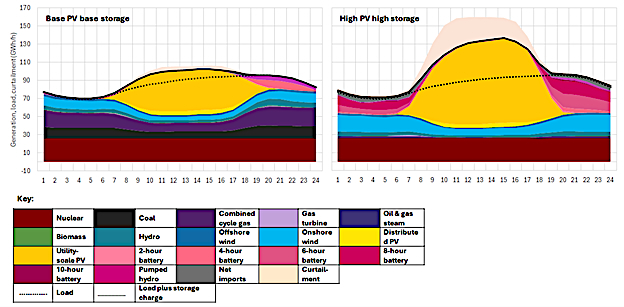Berkeley Lab and NREL Study Examines High Levels of Solar and Storage in the Southeast
Solar energy has the potential to be a core energy resource in the Southeastern U.S., especially when combined with investments in electricity storage. Currently, solar photovoltaic (PV) generation contributes less than 5% of the region’s electricity, but some utilities in the Southeast are exploring resource planning scenarios in which solar PV accounts for as much as 40% to 45% of generation by the mid-2030s to 2040s, accompanied by gigawatt (GW) scale investments in electricity storage.
To better understand the impact of increased levels of solar and storage in the Southeast, a new Berkeley Lab and the National Renewable Energy Lab (NREL) report, Solar and Storage Integration in the Southeastern United States: Economics, Reliability and Operations analyzes how higher levels of solar PV (27%-43% of total generation capacity) and electricity storage (13%-49% of peak load) would affect electricity system reliability, costs, and operations across the region in 2035. The study also evaluates the benefits of operational coordination among utilities through more efficient regional dispatch and reserve sharing, at different levels of solar and storage. The study focuses on five balancing regions that cover Alabama, Georgia, Kentucky, North Carolina, South Carolina, Tennessee, and parts of Mississippi and Missouri.
Join Berkeley Lab experts and the U.S. Department of Energy’s Solar Energy Technologies Office to learn more about the report during a free webinar on October 3rd at 10:00 am Pacific/1:00 pm Eastern.
Presenters include:
- Ammar Qusaibaty, U.S. Department of Energy, Solar Energy Technologies Office
- Fritz Kahrl, Berkeley Lab affiliate
Register for the webinar at https://lbnl.zoom.us/webinar/register/WN_x6Fdz8CjR3i1Df1HuvG95Q. The report and resource portfolios developed for the analysis are available at https://emp.lbl.gov/publications/solar-and-storage-integration.
Key findings include:
Higher solar and storage systems operated reliably. Detailed operational (day-ahead and real-time) modeling of a range of higher solar and storage resource portfolios did not result in significant reliability issues in the Southeast, measured in terms of lost load and reserve shortages. However, the nature and timing of operating challenges changed with different levels of solar and storage – for instance, in a few cases reserve shortfalls occurred in the early morning hours following low solar days. Some of these new challenges could be addressed through demand-side flexibility and changes in operating practices, including how storage is operated and a shift from hourly to sub-hourly day-ahead scheduling.
Operational coordination lowered costs and emissions and improved reliability. Higher levels of operational coordination, through more efficient regional dispatch and reserve sharing, was not necessary to reliably operate higher solar and storage electricity systems in the Southeast. But more efficient regional dispatch reduced production costs by 1%-2% and CO2 emissions by 3%-7% in the Southeast and its neighboring regions. Reserve sharing in the Southeast reduced day-ahead reserves by 5%-23% and often reduced reserve violations. The Southeast and its neighbors were highly interactive, suggesting that it will be important for utilities in the Southeast to account for how resource mixes in these other regions are changing in their resource planning, transmission planning, and operations.
Solar and storage were economically and operationally interdependent. The close relationship between solar and storage could be clearly seen in dispatch results. In the medium and higher solar scenarios, most (42%-63%) incremental solar generation was stored and time shifted to evening and morning hours rather than used to meet load when solar was available (see figure). Storage operations, in turn, followed the solar cycle, charging during the daytime and discharging in the evening and, in higher solar scenarios, early morning. However, the ratio between solar and storage capacity varied significantly across scenarios, suggesting that careful analysis is needed to determine the most economic levels of storage to pair with investments in solar.

Onshore wind was an important resource for achieving higher levels of CO2emission reductions. When CO2 emission reductions reached 75% to 80% relative to 2022 levels, solar generation in the Southeast study region began to saturate, meaning that additional reductions in solar and storage costs in capacity expansion modeling (resource portfolio development) did not lead to significant additions of new solar capacity. Beyond this point, onshore wind was the most cost-effective resource for reducing emissions in the region. More significant changes in expected solar and storage costs, different assumptions about solar plant performance, limits on wind development and procurement, and changes in assumptions about load growth and load shapes would likely change the level at which solar saturates. Nevertheless, it would be beneficial to explore onshore wind availability within the Southeast region and the feasibility of out-of-state wind procurement.
The authors of the report are Fritz Kahrl, Jennie Jorgenson, Lawryn Kiboma, James Kim, Dev Millstein, Brian Sergi, and Natalie Mims Frick. The U.S. Department of Energy’s Solar Energy Technologies Office supported this work.
Berkeley Lab | emp.lbl.gov










.png?r=1664)

